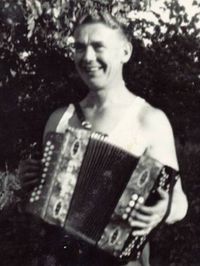Annotation:Hot Punch (1)
X:1 T:Hot Punch [1] M:6/8 L:1/8 K:G d2c | B2G GFG | E2G D2G | B2G BdB | G3A2B | c2A AGA | F2A A2G | F2D FAF | D3d2c | B2G GFG | E2G D2G | B2G BdB | G3-G2d | dBd cAc | BGB A2A | D2D DEF | G3 || d2c | B2d dcd | B2d dcd | B2G BdB | G3A2B |c2A AGA | F2A A2G | F2D FAF | D3d2c | B2d dcd | B2d d2c | B2G BdB | G3-G2d |dBd cAc | BGB A2A | D2D DEF | G3 |]
HOT PUNCH [1]. AKA and see "Blue Bonnets Hornpipe," "Frolic (The)," "Orange and Blue (2)," "Lick the Laddle Sandy (2)," "Queen's Marriage (The)." Scottish, Jig. D Major. Standard tuning (fiddle). AB. Usually known as "Orange and Blue," by which title it is widely printed. The word 'punch' derives from a Hindi word, panch, meaning 'five', because of its five ingredients: spirits, water, lemon-juice, sugar and spices. The word was first recorded in English in 1669. 4/4 time versions of the melody go under the title "Frolic (The)" (e.g. William Vickers), among others (see alternates, above). The tune was popularlized in the mid-20th century by melodeon player Bob Cann (Dartmoor).


